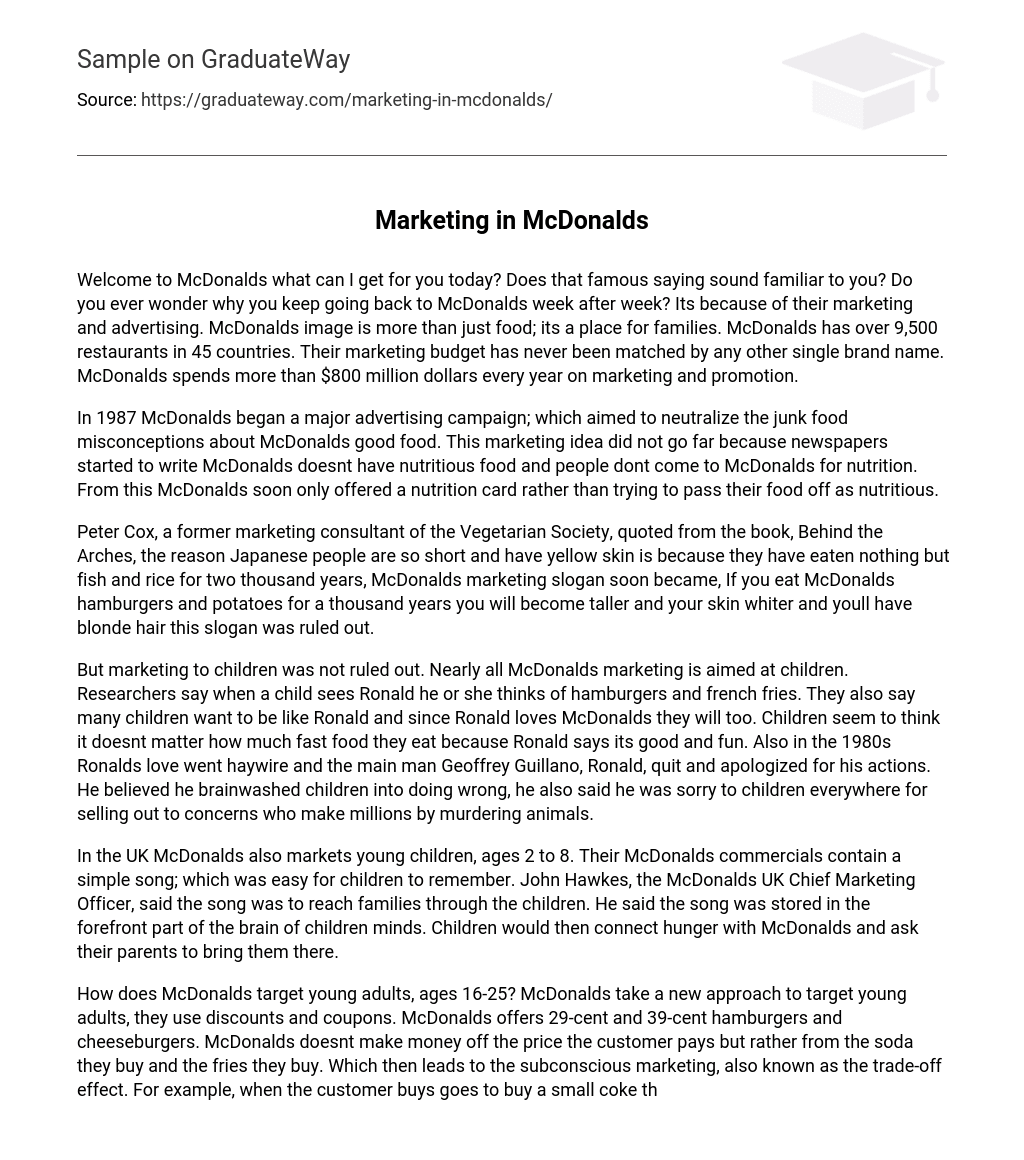Welcome to McDonalds! Can I help you with your order? Have you ever wondered why you consistently choose McDonalds every week? Well, it all comes down to their successful marketing and advertising strategies.
McDonalds is more than a restaurant; it is a family haven that distinguishes itself from other brands through its impressive annual marketing budget of $800 million. This can be seen in its widespread presence, with over 9,500 restaurants spread across 45 countries.
Back in 1987, McDonald’s initiated a major advertising campaign to tackle the concerns regarding the healthiness of their food. Nevertheless, this endeavor proved futile when newspapers started highlighting that McDonald’s meals were not nutritious, thereby creating a perception that the restaurant lacked nutritional value. Consequently, McDonald’s opted for a different strategy by introducing a nutrition card instead of solely focusing on the nutritional value of their menu.
Peter Cox, a former marketing consultant of the Vegetarian Society, stated that according to the book Behind the Arches, Japanese people are allegedly short and have yellow skin due to their diet of fish and rice for two thousand years. McDonald’s marketing slogan at the time suggested that if one consumed their hamburgers and potatoes for a thousand years, they would become taller, have whiter skin, and blonde hair. However, this slogan was ultimately rejected.
Despite not ruling out marketing to children, McDonald’s primarily targets children in their marketing efforts. According to researchers, when children see the character Ronald, they associate him with hamburgers and french fries. Moreover, many children aspire to be like Ronald, subsequently developing a preference for McDonald’s. Children seem to disregard the potential consequences of consuming excessive fast food as Ronald promotes its goodness and fun. Additionally, in the 1980s, Geoffrey Guillano, who was the main person behind Ronald, resigned and expressed remorse for his actions. He believed that he had influenced children in a negative way and apologized to children everywhere for aligning with companies that profit from animal slaughter.
McDonalds in the UK aims its commercials at children between the ages of 2 and 8 by using a catchy song. John Hawkes, McDonalds UK’s Chief Marketing Officer, stated that the goal of the song was to engage families by directly appealing to children. Hawkes explained that the intention behind creating this song was for it to be memorable to children and connect hunger with McDonalds, thus encouraging them to request a visit from their parents.
McDonald’s has implemented an innovative strategy to target young adults, particularly those aged 16 to 25. To attract this specific demographic, McDonald’s utilizes various tactics like offering discounts and coupons. The fast-food chain sells hamburgers at a price of 29 cents and cheeseburgers for 39 cents. It is important to note that these low-priced food items are not the primary source of revenue for McDonald’s. Instead, the majority of their profits come from additional purchases made by customers, specifically soda and fries. This marketing technique is commonly known as the trade-off effect or subconscious marketing.
For instance, when customers initially plan on buying a small coke priced at $1.09, they often end up selecting a larger size instead because the medium one costs slightly more at $1.24 while opting for a large coke only slightly increases the price to $1.29. As a result, customers are influenced by these prices as they assess which option provides them with the best value for their money.
The medium soda is priced at $0.15 more than the small size, but it provides an extra 5 ounces. On the other hand, the large soda costs $0.05 more than the medium size, yet it offers 11 extra ounces for that extra nickel. Consequently, the customer ends up purchasing a soda that is two sizes larger than their initial plan. Despite spending $0.20 more than intended, McDonald’s incurs minimal costs.
Customers can follow the same procedure for ordering french fries. The pricing is as follows: a medium size costs $1.29, a large size costs $1.59, and a super size costs $1.79. In comparison, the large fry costs an additional $0.30 compared to the medium fry, while the super fry is only $0.20 more expensive than that. Therefore, customers believe that if they are willing to spend an extra $0.30 for a larger portion of fries, it would be wise to invest an additional $0.20 for what they consider as the best value for their money.
Overall, we all fall victim to being the target audience regardless of whether it’s for McDonalds or Radio Shack. Many of us give in to marketing tactics and buy more than what we initially intended. The effectiveness of marketing is what distinguishes one store from another. Therefore, when you decide to shop somewhere next time, consider if your choice was influenced by their persuasive strategies or your own desire.





